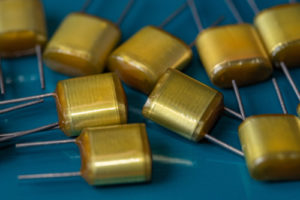APPLICATIONS OF TECHNOLOGY:
- High temperature film capacitors
- Electrical energy storage materials
- Polymer materials
BENEFITS:
- High dielectric constant
- High dielectric breakdown strength
- High glass transition temperature
- Readily soluble in Dimethylformamide (DMF), Dimethylacetamide (DMAC), and N-Methylpyrrolidone (NMP) for solution processing
- Thermoplastics compatible with traditional melt extrusion processing
BACKGROUND:
- Dielectric materials are insulators that can be polarized by an external electric field. When used in a capacitor, the polarization of the dielectric allows for storing a greater amount of charges and therefore more energy. The higher the dielectric constant of the insulator, the more energy the capacitor can store, but this is limited by the conditions under which the material can continue to be an insulator. At high temperatures or high electric fields, the dielectric material can ionize or break down, becoming conductive and destroying its dielectric properties.
TECHNOLOGY OVERVIEW:
Berkeley Lab researchers have developed a class of polymer-based capacitors that remain stable at high temperatures. Polysulfates and polysulfonates exhibit high dielectric constants ranging from 3.4 to 3.8 and high dielectric breakdown strengths greater than 600 MV/m, making them especially suited for use in high energy density electrostatic capacitors. Because polysulfate- and polysulfonate-based polymers have high glass transition temperatures that can reach over 150 °C, they can be used in high temperature applications where many other dielectric polymers would fail. At 150 °C, these polymeric dielectrics were able to achieve a discharge energy density of 6 J/cm3 at an electric field strength of 600 MV/m. Researchers also modified the dielectric films with thin oxide coatings on both sides that increased the energy density to 8.6 J/cm3 at a field strength of 750 MV/m.
In terms of fabrication and scalability, the polymers themselves are soluble in common solvents like DMF and NMP and are compatible with the melt extrusion processing that is typically used in film capacitor manufacturing. The oxide coating is straightforward to manufacture and follows a general process that can be used for a number of different metal oxides.
DEVELOPMENT STAGE: Performance validated at laboratory scale
PRINCIPAL INVESTIGATORS:
- Yi Liu
- He Li
- K. Barry Sharpless
- Peng Wu
STATUS: Patent pending.
OPPORTUNITIES: Available for licensing or collaborative research.
